The Role of the Church in the Destruction of the Culture and Heritage of the indigenous people of America
The Earliest Missionaries who came to Assam were Americans. A few days ago, I wrote how Naga’s were Christianised by Missionaries.
Let us read what they did at America. The summary answer is: The white people invaded, forcibly occupied the lands of the Native Americans and preached Christianity to them. But let’s go back even further, before the whites bothered to look west.
It was in the 17th century that Puritans and other Separatist Protestant groups, purportedly fleeing from religious persecution in England, first landed in the region today known as New England in the United States. Puritans are those who advocated ‘purity’ in both worship and doctrine following the English Reformation. They felt that the English Reformation had not gone far enough and was in fact still tolerant of certain practices that were associated with Roman Catholicism. Therefore, it was necessary that the Church of England subject itself to further reformation so that it could become a true Christian nation.
The Separatist Protestant groups included the Presbyterians, Baptists, Quakers and any other protestant denomination that wanted to separate itself from the Church of England.
On their arrival in America, they pronounced the land they had reached as the Promised Land where they had been brought by divine providence to build a Christian commonwealth, ‘a city set upon the hill’ firmly rooted in Christian principles for the entire world to see. The Pemaquid and Wampanoag people who first saw the arrival of Separatists at Plymouth in 1620, regarded the latter as helpless, as they had been struck by an epidemic on their arrival and many of them had already died. Therefore, moved by concern, they shared their corn with them, showed them where and how they could catch fish, and later, they even gave them some seed corns and showed them how to cultivate it. Every year in America, this is celebrated as the holiday of Thanksgiving, the third Thursday of every November.
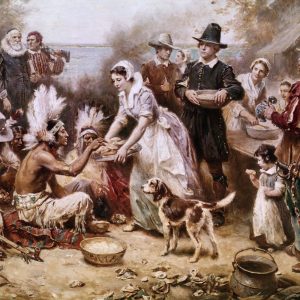
A depiction of the first thanksgiving meal
But, the white settlers could never be grateful to the goodwill shown to them by the Native Americans, in whose land they had slowly begun to settle. They were so imbued with notions of being the chosen people of God, set apart to build a Christian commonwealth in the Americas, that they could never acknowledge those who were racially, spiritually and culturally different from them as equals, worthy of dignity and respect.
A couple of years into their stay at Plymouth, after enjoying the goodwill of the Native Americans, the white settlers developed a militia of their own, set up their own government and began looting the resources of the local inhabitants and dispossessing them of their land in a more organized manner. In the meantime, further shiploads of white settlers poured in, craving for more land and resources. A group of English Puritans with the assistance of Massachusetts Bay Company arrived in the lands belonging to Massachusett people and in 1630, and set up their own administration. As this colony expanded following the arrival of more white settlers, military campaigns were organized leading to the large scale massacre of Native Americans and the continuous destruction of their homes, cattle and crops.
Following the massacre, a Puritan theologian named Cotton Mather defended the act. He wrote: “It was supposed that no less than 6oo Pequot souls were brought down to hell that day”. Imbued with Calvinist notions of predestination, the white settlers saw themselves as the chosen ones, the ‘elect’, whose license to salvation had already been guaranteed. They firmly believed that everyone who was not them and who stood in the way of their interests was destined for hell anyways. Along with the conquest for land, the urge to convert the Native Americans to Christianity was an intrinsic part of the Charter of Massachusetts Bay, 1629, upon which the English government granted the colony to the Puritans.
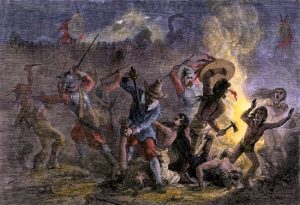
Depiction of the massacre of 600 Pequot Native Americans by whites
The Charter stated that the principal end of the colony being granted was to “win and incite the Natives of Country, to the Knowledge and Obedience of the only true God and Savior of Mankind, and the Christian Faith.” It so happened that Puritans once settled in the new colony, probably because of the fear that the ‘natives’ would taint the ‘purity’ of the Christian commonwealth they wished to build, the Puritans seemed less enthusiastic about winning Native Americans to Christianity.
This became a matter of concern for the English Parliament who had granted the colony and questions regarding the slackness of the Puritans of Massachusetts in this regard were increasingly raised. It is under this political pressure to improve the public image of the colony in Britain that the administration of Massachusetts Bay Colony encouraged, John Eliot, a Puritan missionary, to begin missionary work among the Massachusett tribe in 1646.
The government offered him all support and protection. To make his task easier, legislation that made blasphemy a capital crime and the practice of traditional Native American religion unlawful were also passed.
The subsequent missionary work included breaking down of existing communities and organization of people into villages known as ‘Praying Towns’, which would be under the firm political control of the Massachusetts administration; undermining traditional tribal leadership and fostering new leadership; integrating traditional economy with the white settler economy and forging a relationship of economic dependency; imposition of European customs and modes of agriculture, architecture, clothing, etc.
In 1675, following the uprising of Wampanoag Chief, Metacom, ‘Praying Towns’ collapsed and missionary work was discontinued.
Metacom formed alliances other tribes in the region, and waged a war against the white settlers. The Native American confederacy attacked 52 settlements, of which, about 12 were completely destroyed. However, after months of fighting, the firepower of the white settlers prevailed, almost exterminating the Narrangansetts and Wampanoags. Metacom was killed and his head was put up as a public exhibit in Plymouth for the next twenty years; and, his wife and son, along with other Native American women and children were sold into slavery in the West Indies.
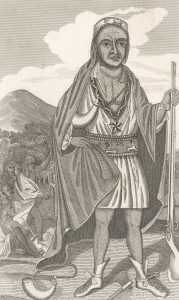
Artist’s depiction of Metacom
The Five Nations of the Iroquois, who were considered the strongest of the Native American people, after years of resistance, was defeated. In the 1760s, Pontiac of the Ottawas formed an alliance of tribes around the Great Lakes in order to protect their land but was again defeated. Wherever land was taken, Native Americans were massacred, and new settlements were built, the Baptist and the Methodist settlers moved in, preaching and establishing their churches and thereby, extending their influence.
Meanwhile, the ‘Second Great Awakening’ occurred. This was another religious revival & more brutal that began in the late 18th century. The American Revolution during the latter half of 18th century is said to have weakened the hold of religion over the people and secularized the social, cultural and political landscape.
In such circumstances, the church leaders became increasingly anxious to expand their influence among all sections of the society, lest religion itself become obsolete in the lives of the people. The revival movement began among the educated elite of New England and subsequently spread among the farming and small trading communities in the new white settlements in the frontier regions.
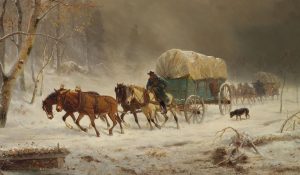
Depiction of the so-called “pioneers” of America
The late 18th century and much of the 19th century witnessed unprecedented waves of migration of Europeans to North America. The related hunger for land, resources and profits continued to drive the white settlers into the lands of the Native Americans, with the latter being pushed further westwards. Furthermore, laws such as Indian Removal Act, which guaranteed the forcible eviction of Native American people from their lands, were enacted.
The Native Americans continued to resist. Towards the beginning of 19th century, Tecumseh of the Shawnees formed an alliance of Midwestern and southern tribes and waged a war in order to protect their land, but they were defeated with Tecumseh himself being killed during the War of 1812.
Following which, white settlers poured into the Illinois country. The Sauks and Foxes who inhabited the region fled across the Mississippi. One of their Chiefs, Black Hawk, formed an alliance with the Winnebagos, Pottawotamies and Kickapoos and waged a war against the new settlements but was again brutally suppressed. Black Hawk was eventually captured in 1832, was imprisoned and taken around as an exhibit for white settlers to revel in their fantasies of superiority. Between 1795 and 1840, the Miamis held out several times against the white settlers but they too were suppressed and forced to give away their land.
Similarly, thousands of Cherokees, Chickasaws, Choctaws, Creeks and Seminoles were massacred under the leadership of Andrew Jackson, a merchant, speculator and slave trader, who later became the President of the United States; their lands were taken and sold to the growing white settler community.
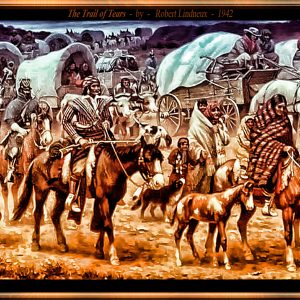
Artist’s depiction of the Trail of Tears, an act of ethnic cleansing against the Cherokee people
Every act of resistance was dealt with similar brutality, and the white settlers continued their move westwards for more land & eventually conquered all of America.
This genocide continued throughout the 19th century and eventually, the Native Americans who remained were confined to settlements known as Reservations, where every movement and action of theirs was put under strict surveillance.
Needless to say, the exclusivity inherent in salvation through Christ alone theology and the related disregard for other religious persuasions, the urge to convert the ‘heathen’ and the growing hunger for land in, what Howard Zinn calls, a “barbarous epoch of history ruled by competition” made the expansion of white settlers to the western frontier a very brutal and bloody affair as far as the Native Americans were concerned.
Past behavior predicts present conduct. Now we know why American missionaries continue to expand globally and target various groups in India. It would be reasonable to assume that America should be labelled a country of particular concern; most of the missionaries we catch violating visa laws (see this example, but there are many more on our website) come from America. They have had success with the Nagas. We need to stop them before they convert other tribes and other groups in India!






